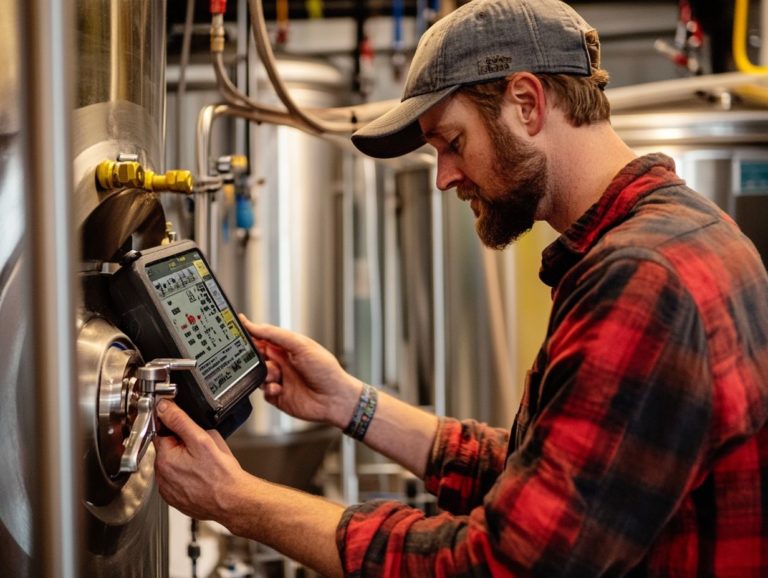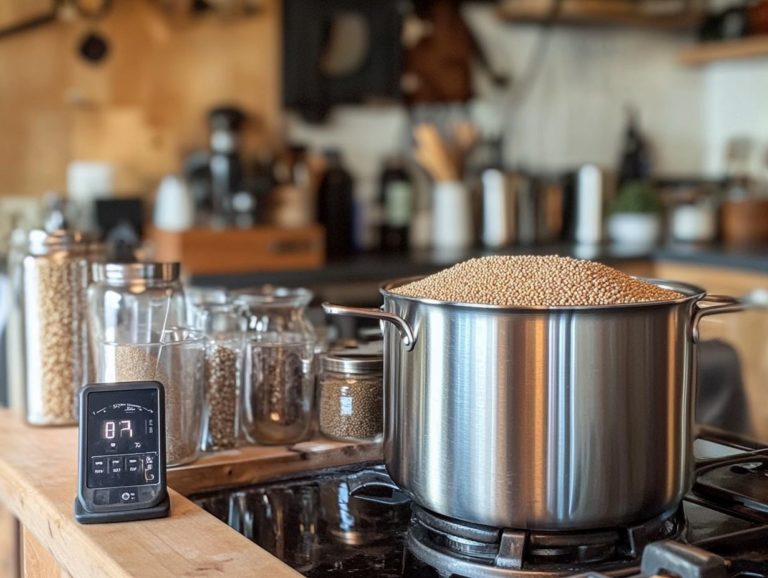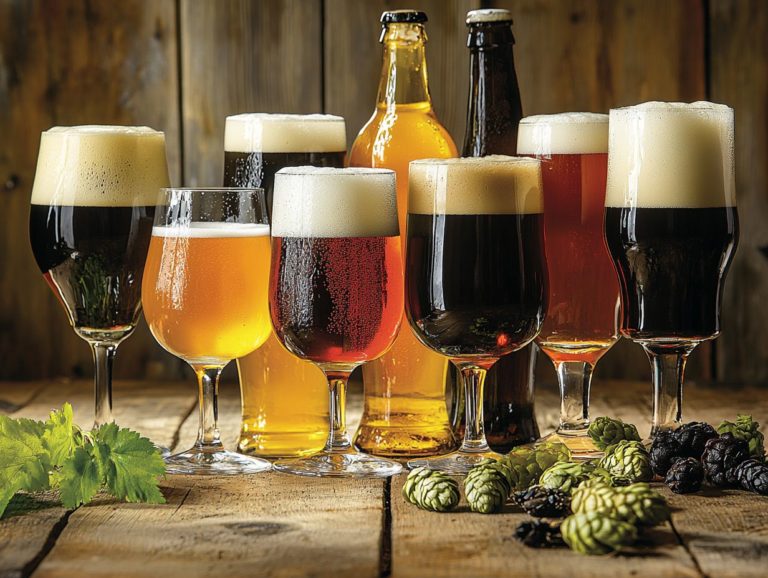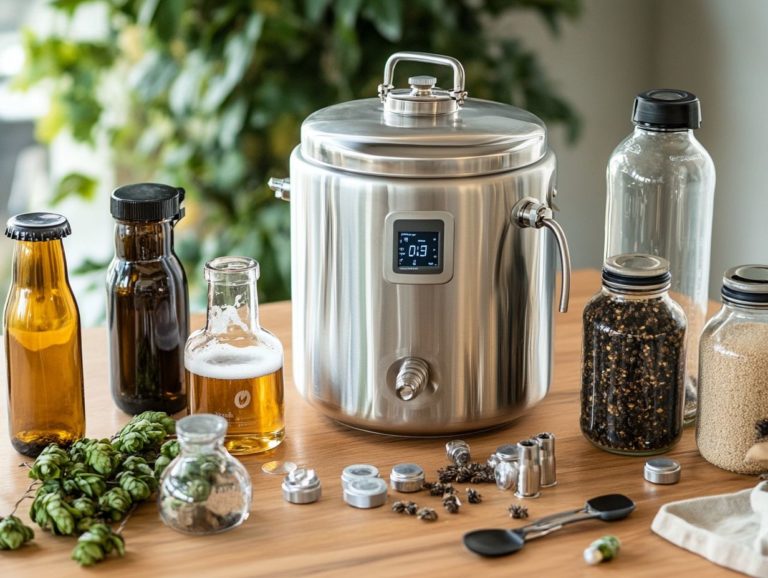How to Create a Home Brewing Schedule
Contents
- Home Brewing: A Comprehensive Guide
- Key Takeaways:
- What is Home Brewing?
- Why Create a Brewing Schedule?
- How to Create a Home Brewing Schedule?
- What are the Different Approaches to Home Brewing Schedules?
- 3. Extended Schedule
- How to Adjust a Brewing Schedule?
- Final Tips for a Successful Brewing Schedule
- Frequently Asked Questions
- Homebrewing: A Fun and Rewarding Hobby
- What are some enjoyable beer styles I can brew?
- What is a homebrewing schedule?
- Why is it important to have a homebrewing schedule?
- How do I create a homebrewing schedule?
- Can I customize my homebrewing schedule?
- How often should I follow my homebrewing schedule?
- What should I do if I miss a step in my homebrewing schedule?
- Final Tips for Successful Homebrewing
Home Brewing: A Comprehensive Guide
Home brewing is an exhilarating and fulfilling hobby that empowers you to create your own distinctive beers, making you a true craft beer crusader.
Achieving success in brewing goes beyond simply gathering the right ingredients; it also demands meticulously planning and scheduling.
This guide delves into the fundamentals of home brewing, highlighting the significance of establishing a brewing schedule. You ll uncover its advantages, identify common pitfalls to steer clear of, and follow step-by-step instructions to develop a brewing plan tailored to your needs, utilizing tools like brewing software and a brewery management platform.
Whether you re just starting out or you re a seasoned brewer, this information is crafted to elevate your brewing experience and guarantee delectable results every single time.
Key Takeaways:

- Creating a home brewing schedule helps ensure consistency and efficiency in the brewing process and takes advantage of consumer preferences.
- Consider factors such as type of beer, necessary ingredients and equipment, fermentation time, and seasonal inventory when creating a brewing schedule.
- Be prepared to adjust the brewing schedule for unexpected delays or changes in brewing methods, ingredients, or seasonal offerings.
What is Home Brewing?
Home brewing is your ticket to the fascinating world of beer production on a more intimate scale, typically for personal enjoyment. It gives you the power to experiment with a variety of brewing methods.
You can explore unique beer styles and even craft your own recipes. This hands-on approach not only sparks your creativity but also deepens your understanding of the brewing process.
Understanding factors such as selecting the perfect raw materials and nailing fermentation temperatures, like those required for high gravity beers, is crucial.
As a home brewer, you can tailor your beer to your exact preferences, whether you lean toward refreshing ales or rich, dark brews. And there s nothing quite like sharing your creations with friends and family, making it a truly rewarding hobby for craft beer aficionados.
In recent years, the popularity of home brewing has skyrocketed, fueled by a burgeoning interest in craft beer and the desire to produce something uniquely yours.
You can dive into a vast array of beer styles, such as IPAs, stouts, and sours, each presenting its own delightful flavors and aromas. Also, consider brewing varieties for each season, like imperial stouts in summer or lighter ales for spring.
With countless brewing recipes at your fingertips, dive in confidently! Even beginners can find helpful guidance to kickstart their brewing journey.
The home brewing community provides a warm and supportive space where you can exchange tips, tricks, and experiences, enriching your brewing adventure.
Whether you re experimenting with new ingredients or perfecting a cherished recipe, this hobby intertwines enjoyment with camaraderie among fellow beer enthusiasts.
It also provides the opportunity to manage brewing schedules and share insights on brewing day.
Why Create a Brewing Schedule?
Creating a brewing schedule is integral to managing brewing schedules effectively and ensures that your homebrew is ready when you expect it.
Establishing a brewing schedule is essential for both home brewers and commercial breweries. It serves as a cornerstone for meticulous planning and scheduling.
This guarantees a seamless brewing session, optimizes resource allocation, and aligns production with market demand.
By adopting a well-structured brewing schedule, you can adeptly manage raw material ordering, control your beer inventory, and capitalize on seasonal offerings.
Examples include Oktoberfest in October or holiday spiced ales, ultimately elevating the overall operation of your brewery.
What are the Benefits of Having a Brewing Schedule?
Establishing a brewing schedule offers numerous advantages that elevate your brewing operation to new heights. It enhances your efficiency in managing the brewing process, allows for precise tracking of your beer inventory, and aligns production with a seasonal brewing calendar. This means you can strategically highlight the appeal of seasonal offerings, like holiday spiced ales or Oktoberfest brews in October, and even plan to brew in the fall for specific seasonal flavors.
By adopting this structured approach, you not only minimize brewing challenges but also streamline the ordering of raw materials and plan tank space effectively, setting the stage for a successful brewing operation. Moreover, this proactive planning aids in brewing inventory management, ensuring you have the necessary ingredients at all times.
When you establish a brewing schedule, you also optimize the use of your equipment, ensuring each tank is utilized to its fullest potential while reducing downtime between batches. This proactive strategy gives you the power to forecast demand more accurately, which is essential when gearing up for seasonal favorites that experience peak popularity, such as crisp lagers in the summer or rich stouts in the winter. It also allows you to take advantage of brewing in advance for high-demand periods.
A well-thought-out schedule promotes collaboration among your team, from brewers to sales personnel, enhancing communication and providing clarity regarding production timelines. As a result, this level of organization nurtures a more agile brewery, one that can dynamically and efficiently adapt to evolving market trends. Additionally, using a brewing software or brewery management platform can further streamline this process.
What are the Common Mistakes to Avoid in a Brewing Schedule?
When you re crafting a brewing schedule, it s crucial to avoid common pitfalls that can significantly disrupt the brewing process. Failing to account for brewing timing or neglecting an accurate assessment of your beer inventory can lead to stockouts or even overproduction. Ensuring you have a home brewing calendar can help in tracking these key elements.
Many brewers underestimate the importance of brewing ahead of time or misjudge fermentation temperatures, complicating the brewing session and ultimately compromising the quality of their products.
Such oversights can waste valuable time and resources while introducing inconsistencies in your final product. Accurate timing is paramount; rushing fermentation can result in undesirable off-flavors, while letting it drag on can impact your beer’s clarity and carbonation.
Conducting a thorough inventory assessment ensures that all essential ingredients, like hops and malts, are ready when you need them, preventing any unexpected delays. By prioritizing meticulous planning and grasping the nuances of each brewing phase, you can create beers that not only meet your high standards but also shine in a competitive market. This is particularly crucial when brewing high gravity beers, as the specific ingredients and timing can greatly impact the final product.
How to Create a Home Brewing Schedule?
Creating your home brewing schedule involves several essential steps that enable you to manage the brewing process with finesse, ensuring that every batch of beer be it a rich imperial stout for summer or a refreshing lighter ale for spring is crafted with precision and care. Utilize your home brewing calendar to keep track of these important details.
By adopting a structured approach, you can effectively plan your brewing sessions, allocate ample time for fermentation, and even explore various brewing techniques. This methodical strategy gives you the power to produce a delightful array of beer styles throughout the year, transforming your brewing experience into a year-round celebration of craft. Brew in the spring, summer, fall, or winter, and enjoy the unique flavors each season brings.
1. Determine the Type of Beer to Brew
Identify Your Preferences
The first step in crafting your home brewing schedule is to pinpoint the type of beer you want to create. Do you have a love for seasonal delights like pumpkin beer in the fall, or are you drawn to year-round favorites such as a smooth cream ale? By identifying your preferred beer styles, you can customize your brewing recipes and refine the brewing process to elevate the flavors and aromas. This will enrich your craft beer experience.
Also, consider using a seasonal beer brewing calendar to plan beers for each season efficiently. Embracing seasonal trends is crucial, as certain styles truly shine at specific times of the year, while others may offer comfort and satisfaction throughout all seasons.
Consider Seasonal Trends
Consider how factors like the weather, holidays, or local events can change what people want to drink at any given moment. Seasonal inventory and fast-moving beers should be taken into account when planning your brewing schedule.
Explore Beer Styles
Take the time to explore which beer styles resonate with your palate and don t shy away from experimenting with diverse flavor profiles. This exploration will ensure your brewing journey remains both gratifying and invigorating. Keep the seasonal beer brewing calendar in mind; planning ahead allows you to streamline your brewing process, maximizing the quality and enjoyment of each batch you produce, and ensuring that you can drink your beer at its peak time.
2. Gather Necessary Ingredients and Equipment
Prepare Ingredients

Before embarking on your brewing session, it’s crucial to gather all the necessary ingredients and equipment to ensure a seamless brewing experience. This includes selecting quality grains for your beer and ordering raw materials well in advance. By preparing thoughtfully, you not only ensure that everything you need is at your fingertips but also familiarize yourself with the brewing methods at play, enhancing the overall flavor and quality of your final product.
Organize Equipment
Utilizing brewing software can help manage grain needs and other raw material requirements effectively. Taking the time to prepare means that whether you’re using a straightforward stovetop method or a more intricate all-grain setup, all essential tools like fermentation vessels, measuring devices, and heat sources are readily available.
Different brewing techniques may require specific ingredients, such as various hop varieties or specialty malts, which can dramatically influence the taste profile of your brew. Ensure that you also have a plan for brewing in advance, especially for seasonal favorites.
By meticulously organizing these materials ahead of time, you can streamline the entire process, minimizing the risk of interruptions and mistakes. This leads to a more enjoyable brewing experience and, ultimately, a superior beer. Having a robust brewery schedule planning in place can further help in managing these complexities effectively.
3. Calculate the Brewing Time
Understand Brewing Timings
Calculating the brewing time is essential to your home brewing schedule, encompassing not just the brewing process itself but also the vital fermentation and conditioning periods needed to develop the unique flavors of your chosen beer styles. By accurately estimating these timeframes, you can strategically plan your brewing sessions, ensuring that your homebrew is perfectly timed for consumption.
Proper brewing timing also ensures that you meet deadlines for local events or holiday seasons, like having a perfect Hefeweizen ready for St. Patrick’s Day. To master this process, familiarize yourself with the typical fermentation and conditioning durations associated with different beer styles.
Monitor Fermentation
For example, ales usually require a shorter fermentation period, often around one to two weeks, whereas lagers may need more time sometimes exceeding four weeks due to their cooler fermentation temperatures. High gravity beers like imperial stout and barleywine may also require extended conditioning periods.
Keeping a keen eye on specific gravity readings during fermentation will offer you valuable insights, indicating when yeast activity has wrapped up. Specific gravity readings help you track the fermentation process. Additionally, allocating time for conditioning is crucial; it allows your beer to mature, enhancing carbonation and flavor integration, and ultimately leading to a more satisfying tasting experience.
This is especially important for seasonal offerings like holiday spiced ales which may require specific conditioning periods. Mastering brewing time means you’ll always have the perfect beer ready for your next celebration!
4. Plan for Fermentation and Conditioning Time
Planning for fermentation and conditioning time is an essential aspect of your home brewing schedule. This stage can profoundly influence the flavor profile and overall quality of your beer.
By understanding the fermentation process, including the intricacies of fermentation temperatures and the variations that can arise from different brewing methods, you ll be able to maximize the effectiveness of this critical phase.
Different fermentation techniques, such as primary and secondary fermentation, offer you varied outcomes. They invite you to experiment with a rich array of flavors and aromas.
Typically, primary fermentation lasts about one to two weeks. Meanwhile, secondary fermentation can enhance the clarity and complexity of your brew over the course of a few additional weeks.
These techniques can be especially useful when brewing in advance for specific events like Oktoberfest in October or St. Patrick’s Day in March.
Being mindful of environmental factors such as temperature fluctuations and yeast behavior will help you steer clear of unwanted off-flavors.
In crafting distinctive brews, recognizing the subtle nuances of fermentation gives you the power to create well-balanced and enjoyable beers that truly reflect your unique brewing session and mastery of the craft, whether you brew in the winter, spring, summer, or fall.
5. Consider Secondary Fermentation or Dry Hopping
Considering secondary fermentation or dry hopping in your home brewing schedule can significantly enhance the complexity and aroma of your beer. This is especially true for styles that thrive on these techniques, like IPAs, Belgian ales, or even darker beers like stouts and bocks.
By integrating these methods into your brewing process, you have the opportunity to elevate your beer’s flavor profile and achieve a more sophisticated final product.
Secondary fermentation takes place once the primary fermentation wraps up. This allows the leftover bits from fermentation to settle and flavors to mature.
This phase offers a chance to introduce additional ingredients think fruits or spices that can impart unique characteristics to your brew.
Dry hopping, in contrast, involves the strategic addition of hops during or after fermentation. This enables the extraction of enticing hop aromas without ramping up the bitterness.
Timing is crucial; getting it right is important here. It s advisable to initiate secondary fermentation after the bubbling has subsided, typically around one to two weeks post-initial fermentation.
Always remember to uphold strict cleanliness rules to safeguard the integrity of your brew!
6. Schedule Bottling or Kegging Time
Scheduling your bottling or kegging time is the crowning moment of your home brewing journey. It marks the exciting shift from fermentation to ready-to-drink status.
This step lets you enjoy your homebrew in countless exciting styles, whether you’re crafting a robust barleywine or a refreshing seasonal lager.
Timing is crucial; getting it right helps you avoid the pitfalls of over-carbonation or under-carbonation. This significantly enhances the quality of your final product.
Be sure to take advantage of your brewery management platform to keep track of all these details and streamline your process.
For you, grasping the right moment to bottle or keg is essential. Different beer styles often require distinct approaches. For example, lighter beers may be ready for a quicker turnaround, while richer styles like stouts might thrive with a longer aging period.
Monitoring the specific gravity readings is your best ally in this decision-making process, confirming that fermentation has reached the perfect endpoint.
Don t miss the chance to bottle your brew at just the right moment! Your beer will taste better when you follow the appropriate timing.
Remember, sanitation is paramount during this stage. Diligently adhering to hygiene practices will safeguard all the effort you’ve poured into creating that perfect brew.
By focusing on these crucial details, your transition from fermentation to a beautifully carbonated delight can truly reach its full potential. Your homebrew is ready when it has achieved the desired level of carbonation and flavor integration.
What are the Different Approaches to Home Brewing Schedules?
You have a variety of options when it comes to home brewing schedules. Whether you prefer traditional methods, opt for shortened schedules for quicker production, or choose extended schedules for intricate brewing techniques and experimentation with diverse beer styles, each approach offers its own distinct advantages. Utilizing a home brewing calendar can help you keep track of these methods and their respective timelines.
These choices cater to your brewing preferences and available time, ultimately shaping the entire brewing process and the quality of the finished product.
1. Traditional Schedule
A traditional brewing schedule often encompasses a longer process that facilitates complete fermentation and conditioning. This makes it perfect for intricate beer styles like imperial stouts or barleywines, where flavor complexity reigns supreme. This method ensures that every step of the brewing journey is meticulously executed, culminating in a high-quality final product. Planning and scheduling are crucial to ensure you have the necessary tank space and raw materials available.
Allowing sufficient time for each phase elevates essential characteristics such as aroma, mouthfeel, and finish. This deliberate approach nurtures the emergence of complex flavors, which are vital for varieties that flourish with aging. For example, high-gravity beers benefit immensely from this extended schedule.
The fermentation stage can extend over several weeks or even months, providing yeast the opportunity to fully convert sugars and generate desirable esters and phenols. Such dedication to the brewing process refines the overall palate of the beer and enables the gradual melding of various ingredients, highlighting the artistry that goes into crafting unique brews. This is especially true for your seasonal offerings don’t miss out!
2. Shortened Schedule

A shortened schedule means you can embrace quicker brewing processes, allowing you to craft fast-moving beers like cream ales or lighter-colored ales in a fraction of the time that traditional methods demand. This approach is perfect for those who want to savor their homebrew sooner without sacrificing quality. Using a brewery schedule planning tool can help manage these accelerated timelines effectively.
By employing techniques such as accelerated fermentation and temperature control, you can optimize yeast activity and minimize lag time, enabling you to brew beer in just days instead of weeks. While the allure of faster brewing times is undeniable offering opportunities to experiment with various styles it does come with challenges, such as the necessity for close monitoring to avoid off-flavors. Seasonal inventory and brewing timing are also critical factors to consider in these timelines.
Styles like IPAs and pale ales are particularly well-suited to this method, as they truly shine with fresh hop flavors. Embracing a quick brewing method can be a fun and rewarding way to refine your brewing skills while still achieving delightful results. Fast-moving beers like these can also help you manage your brewing inventory more efficiently. Consider giving this approach a try!
3. Extended Schedule
An extended brewing schedule opens the door to more intricate brewing methods and invites you to experiment with a variety of beer styles. This encourages a deeper exploration of the nuances in brewing and the refinement of your recipes. By allowing fermentation and conditioning to unfold over a longer timeline, you can produce unique flavors and aromas that truly stand out in the craft beer market. Creating enjoyable beer styles is easy with this approach, especially for holiday spiced ales or beers brewed for specific seasons.
This additional time sparks innovation and provides the opportunity to experiment with unusual ingredients and brewing techniques, transforming a standard recipe into something remarkable. With a longer brewing period, you can manipulate the fermentation environment adjusting temperatures or utilizing wild yeast strains leading to unexpected and delightful outcomes. This flexibility enhances the quality of each brew while nurturing your creativity, enabling you to craft distinctive beverages that reflect your personal style and preferences.
Ultimately, this enriches the vibrant landscape of craft beer, making your contributions all the more significant. Taking advantage of a brewery management platform can streamline these creative processes, allowing more room for innovation.
How to Adjust a Brewing Schedule?
Adjusting your brewing schedule is an essential skill for any brewer. Unexpected delays can stem from various factors like equipment malfunctions or shifts in fermentation times. Being able to adapt is crucial for preserving your beer inventory and optimizing overall production efficiency. Using brewing software can assist in managing these changes effectively.
By grasping the nuances of brewing methods and remaining flexible with your timeline, you can minimize disruptions and ensure that each brewing session concludes with success.
1. Dealing with Unexpected Delays
Dealing with unexpected delays in your brewing schedule is part of the adventure, whether it s fermentation hiccups or logistical snags in ordering raw materials. Being ready to adjust your timeline helps you avoid frustration and allows for effective inventory management, ensuring the quality of your beer remains top-notch. Efficient raw material ordering and managing grain needs can significantly mitigate these disruptions.
Adopting proactive strategies to tackle and mitigate these delays is important. For example, maintaining a well-organized inventory of fermentable sugars, hops, and yeast enables you to quickly manage any shortages that arise. Regularly checking fermentation progress, temperature, and specific gravity helps you catch potential issues early, allowing for timely interventions that keep everything on track.
Creating a flexible brewing schedule is another savvy move. This accommodates variations in fermentation timelines, ensuring that even when delays pop up, the overall brewing process stays smooth. To assist with this, consider how to create a fermentation schedule that enhances your adaptability. This can significantly elevate your brewing experience, resulting in craft beers that are nothing short of exceptional. Remember, planning and scheduling are key to managing brewing challenges effectively.
2. Changing Your Brewing Methods
Changing your brewing methods during a brewing session often necessitates significant adjustments to your brewing schedule, particularly when you re experimenting with new recipes or fermentation times that deviate from your usual practices. Embracing flexibility in your schedule is crucial to accommodate these changes and ensure that you can still achieve your production goals. Using brewing software can aid in managing these adaptations seamlessly.
To implement these new brewing methods effectively, meticulous planning is essential. Begin by assessing the specific alterations needed for the recipes you re eager to explore and outline how these modifications will impact each stage of your brewing process. Whether you’re adjusting mash times or tweaking fermentation temperatures, take detailed notes to track how each change influences the final product. Scheduling and tracking these changes can be easier with a brewery management platform.
Pay special attention to the fermentation phase, as this is often the most unpredictable aspect of the brewing schedule. Regularly monitor fermentation temperatures and gravity to stay attuned to the process, ensuring that quality remains uncompromised as you experiment with these new methods. Effective brewing inventory management helps mitigate unforeseen issues during this phase.
3. Incorporating Ingredient Variations
Incorporating variations in ingredients can truly elevate your brewing experience, but it often requires thoughtful adjustments to your brewing schedule especially when new ingredients influence fermentation or conditioning times. Understanding how these variations affect your recipes is crucial for creating consistent, high-quality beers. For instance, adapting your brewing recipes for seasonal offerings can help you brew in the winter, summer, spring, or fall with great results each time.
When you opt for a different type of yeast or introduce unique adjuncts, you may find that fermentation rates and attenuation change significantly. It s essential for you to monitor the specific gravity (a measurement that indicates the sugar content in your wort) and taste closely throughout the brewing process. By making necessary adjustments to your fermentation timelines based on these observations, you’ll enhance the quality of your brews. Incorporating raw material ordering and grain needs into your planning can further optimize your brewing schedule.
Documenting each batch’s timeline and comparing results will help you refine your future recipes. This meticulous tracking and adjustment will empower you to ensure that every brew aligns with your desired characteristics, ultimately enriching the entire crafting process. Brew Day documentation is crucial for refining brewing methods and ensuring consistency across batches.
Final Tips for a Successful Brewing Schedule
- Plan your seasonal inventory wisely to avoid bottlenecks and ensure smooth brewery operation year-round.
- To ensure you have a successful brewing schedule, effective planning is essential, paired with a deep understanding of brewing methods and consumer preferences.
- Align your schedule with seasonal trends and popular beer styles to elevate your brewing experience and craft high-quality homebrew that speaks to your target audience.
- Maintain an adaptable schedule to create enjoyable beer styles for each season.
- Maximize your brewing potential while tailoring your offerings to meet the ever-evolving tastes of your consumers.
- Keep an eye on trending flavors and styles that could excite your audience!
- Establish specific timelines for each brewing session while maintaining flexibility for greater consistency and product excellence.
- Integrate feedback from tastings or polls to gain invaluable insights into preferences, ensuring that every brew resonates with those who appreciate it.
- A well-structured brewing schedule can truly be the cornerstone of your success in the craft beer world. Consider including a home brewing calendar to keep track of all your brewing activities and ensure timely execution.
Frequently Asked Questions
Here are some common questions brewers have about scheduling:

Homebrewing: A Fun and Rewarding Hobby
Homebrewing is an enjoyable and fulfilling activity that allows you to craft your own unique beer flavors. Whether you are a beginner or an experienced brewer, understanding the essentials of homebrewing can enhance your brewing experience.
What are some enjoyable beer styles I can brew?
There are many enjoyable beer styles you can brew, including lighter ales like Cream Ale, darker beers such as Imperial Stout, and seasonal varieties like Pumpkin Beer and Holiday Spiced Ales.
What is a homebrewing schedule?
A homebrewing schedule is a detailed plan that outlines all the steps and timeline for making homemade beer. It includes ordering raw materials, assessing grain needs, and creating an accurate timeline from mashing soaking grains in hot water to extract sugars to fermentation and conditioning.
Why is it important to have a homebrewing schedule?
A homebrewing schedule helps keep track of the brewing process and ensures timely completion of all necessary tasks. It also maintains consistency in beer quality and assists in managing brewing inventories, allowing you to plan for seasonal offerings.
How do I create a homebrewing schedule?
To create a homebrewing schedule, first decide on the type of beer you want to brew and the ingredients you’ll need. Research the ideal brewing timeline for that specific beer and create a concise schedule that includes all the important steps, such as mashing, boiling, and fermentation. Using brewing software can streamline this process.
Can I customize my homebrewing schedule?
Yes, you can customize your homebrewing schedule to fit your specific needs and preferences. If you prefer a longer fermentation period, adjust the timeline accordingly. Just make sure to conduct proper research to understand how any changes may affect the final product, especially for special events like Oktoberfest or St. Patrick s Day.
How often should I follow my homebrewing schedule?
Following your homebrewing schedule is vital for brewing success! While it s important to stick to your plan, be flexible and make adjustments as needed, especially if you encounter unexpected delays or changes in ingredients.
What should I do if I miss a step in my homebrewing schedule?
If you miss a step in your homebrewing schedule, don t panic! Depending on the step you missed, you may be able to adjust and catch up without affecting the final product. However, if a critical step was overlooked, it may be best to start over to ensure your beer’s quality. Always keep a buffer in your homebrewing calendar to accommodate such instances.
Final Tips for Successful Homebrewing
Here are some common mistakes to avoid while homebrewing:
- Don’t skip steps in your schedule.
- Be mindful of temperature control during fermentation.
- Always sanitize your equipment to prevent contamination.
- Keep detailed records of your process for future reference.
With these tips in mind, you re ready to embark on your homebrewing journey and create delicious brews that you can share with friends and family!






